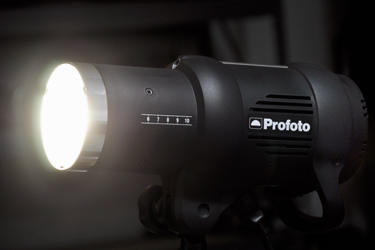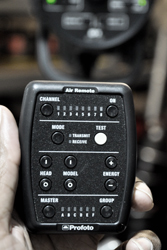Last fall, I got a taste of “rare air” at Photo Plus Expo in New York, courtesy of Profoto and their magnificent Pro-8 Air system. I refer to it as “rare air” because its performance and price point put it in the stratosphere for many photographers and small studio owners. While the blazing speed was impressive, the most interesting aspect of the Pro-8 Air system to me was the switch from the analogue controls of the Pro-7 series to digital and the wireless control capabilities that evolved as a result. I left the show wondering if and when we might see “Air” in other Profoto products.
Last month, with the announcement of the D1 monolights, Profoto has made “Air” available to a broader audience.  It is also an indicator that the Pro Air system is becoming a standard wireless protocol for Profoto products. As a user of Profoto battery packs and ComPacts, I was particularly interested in the D1 system as the specs seemed to address my issues with the current generation of monolights.
It is also an indicator that the Pro Air system is becoming a standard wireless protocol for Profoto products. As a user of Profoto battery packs and ComPacts, I was particularly interested in the D1 system as the specs seemed to address my issues with the current generation of monolights.
If you have ever worked with monolights on a boom or placed high up, you know that making manual adjustments to output can be difficult and time consuming. The Profoto D1 Air system addresses this problem with the Air Remote which literally puts control of the lights in your hand or in the camera hot shoe. No more raising and lowering light stands to fine tune the power or to adjust the modeling lamp. While Profoto is not the first major lighting manufacturer to move in this direction, it is a welcome move nevertheless!

My other issues with the current ComPact units are size and weight: My ComPact 600 from the end of the unit to the tip of the glass cover measures a whopping 16 inches long. The D1 is nearly 5 inches shorter, is lighter, and includes an integrated handle and reflector. While the power may vary, the housing of the D1 units is the same, so if you are shooting with a 250 or a 1000 w/s unit, the physical dimensions of the units are identical, but weight will vary. The D1s also offer a greater degree of lighting control than the ComPacts: 7 stops (500-7.8w/s) adjustable in whole stops or in 1/10 increments versus 5 stops (600-37.5 w/s) adjustable in 1/8 increments; shorter recycling times and for the international traveler, they are multi-voltage.
One of the biggest concerns I had with respect to the D1s design was the built-in reflector. With a 77 degree spread, I worried that light quality/quantity would be compromised especially when using a beauty dish, one of the giant parabolic reflectors, or the magnum reflector. The folks at Profoto must have anticipated this reaction because there is an optional dome-shaped glass cover available that should give the additional spread that many of us are use to. Since I did not have access to the dome, I cannot comment on the spead differential. I suspect that transport and handling concerns may have influenced the decision to go with a built-in reflector.
I found the D1 well-designed, well-built and extremely easy to use. The controls are straightforward and intuitive. Now the D1s come in several flavors: the big question if you are considering the 250 or 500 watt/sec units is whether “to Air or not to Air?” The 1000w/s unit only comes with Air. Personally, I would have to have Air. Much of a photographer’s work is about control, consistency, and efficiency; all benefits of the Pro Air system. Users of the Pro-8s may find the D1s attractive as they are fully compatible and controllable with the same Air Remote and optional software. The optional Air Sync makes it possible to trigger non air equipped packs and monolights. Profoto also has indicated that an external battery will be available, possibly as early as this summer, as an option for the D1 system making it a potent tool for both studio and location work.
The D1s are not priced for the faint of heart. If you have a limited lighting budget, at $1179 for a single 500 w/s Air unit, (the Air Remote must be purchased separately) or $2679 for the D1 500 Air Studio Kit (which includes: two D1 500 Air units; a case; two light stands and umbrellas; and the Air Remote), the D1s may not be a viable option. If, however, you like or use Profoto generators and the Profoto Light Shaping System, or use criteria other than or in addition to absolute cost to determine value, the D1 Air units may be a very attractive and versatile addition to your lighting arsenal.
While I believe the D1s have tremendous appeal on their own and in conjunction with the Pro-8 system, as well as with more products as the Pro Air “stable” expands, for many users of Profoto products like myself, with built in Pocket Wizards, there are some interesting considerations, none of which are product killers or insurmountable. Unlike the Pro-8, there is no option for a built in Pocket Wizard with the D1s. If I were to use a D1 500 Air in conjunction with Pocket Wizard equipped Profoto products, I would use the Air Remote to adjust power, and plug a Pocket Wizard in to trigger the lights. Another option, but in my case not a cost effective one, would be to purchase a couple of Air Syncs to trigger the non air equipped lights and generators. And what about metering? My Sekonic light meter works perfectly with the Pocket Wizard set up. If I were opting to shoot only with the D1 Air units, I would have to set the light meter to “cordless flash mode” and make sure the lights are triggered with the Air Remote within the 90 second timeframe. These are not the most seamless solutions, but they are workable. Profoto does not appear to be resting on their laurels, so the options and considerations may change.
For more information on the Profoto D1s and other Profoto products, click.here.
Update: After purchasing the D1 Airs in April, I discovered that it is possible to mount the Air Remote to a PocketWizard Flextt5, and fire the D1Airs and my PocketWizard equipped packs simultaneously! Additionally, in this configuration, the Sekonic Meter with the PW module will also trigger the D1 Airs. To read more about this, check out my May 5, 2009 entry.


You must be logged in to post a comment.